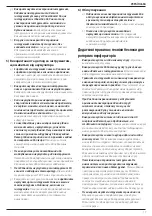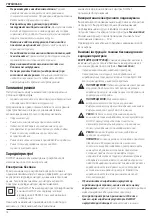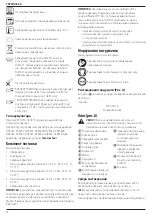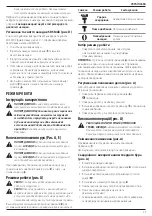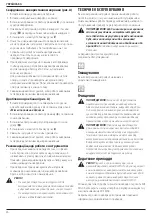
11
English
Side Handle (Fig. A, C)
WARNING:
To reduce the risk of personal injury,
ALWAYS
operate the tool with the side handle properly installed.
Failure to do so may result in the side handle slipping
during tool operation and subsequent loss of control. Hold
tool with both hands to maximize control.
The side handle
2
clamps to the front of the gear case and may
be rotated 360˚ to permit right‑ or left‑hand use.
Mounting the Straight Side Handle
(Fig. C)
1. Widen the ring opening of the side handle
2
by rotating it
anti‑clockwise.
2. Slide the assembly onto the nose of the tool, through the
steel ring
16
and onto the collar
3
, past the chisel holder
and sleeve.
3. Rotate the side handle assembly to the desired position. For
hammerdrilling horizontally with a heavy drill bit, place the
side handle assembly at an angle of approximately 20 ° to
the tool for optimum control.
4. Lock the side handle mounting assembly in place by
securely tightening the handle
2
rotating it clockwise so
that the assembly will not rotate.
Bit and Bit Holder
WARNING:
Burn Hazard.
ALWAYS
wear gloves when
changing bits. Accessible metal parts on the tool and bits
may get extremely hot during operation. Small bits of
broken material may damage bare hands.
The rotary hammer can be fitted with various drill and chisel
bits. depending on the desired application.
Use sharp drill and
chisel bits only.
Inserting and Removing SDS MAX Accessories
(Fig. D)
This machine uses SDS MAX bits and chisels (refer to the inset in
Figure D for a cross‑section of an SDS MAX bit shank).
1. Clean the bit shank.
2. Pull back the locking sleeve
7
and insert the bit shank.
3. Release the locking sleeve and turn the bit slightly until the
sleeve snaps into position.
4. Pull on the bit to check if it is properly locked. The
hammering function requires the bit to be able to move
axially several centimetres when locked in the bit holder.
5. To remove a bit pull back the bit holder locking sleeve/
collar
7
and pull the bit out of the bit holder
6
.
Inserting and Removing the Battery Pack
from the Tool (Fig. B)
nOTE:
Make sure your battery pack
8
is fully charged.
To Install the Battery Pack into the Tool Handle
1. Align the battery pack
8
with the rails inside the tool’s
handle (Fig. B).
2. Slide it into the handle until the battery pack is firmly seated
in the tool and ensure that you hear the lock snap into place.
To Remove the Battery Pack from the Tool
1. Press the release button
9
and firmly pull the battery pack
out of the tool handle.
2. Insert battery pack into the charger as described in the
charger section of this manual.
Fuel Gauge Battery Packs (Fig. B)
Some
D
e
WALT
battery packs include a fuel gauge which
consists of three green LED lights that indicate the level of
charge remaining in the battery pack.
ASSEMBLY AND ADJUSTMENTS
WARNING: To reduce the risk of serious personal
injury, turn tool off and disconnect battery pack
before making any adjustments or removing/
installing attachments or accessories.
An accidental
start‑up can cause injury.
WARNING:
Use only
D
e
WALT
battery packs and chargers.
Anti‑Rotation System and Service Indicator LED
(Fig. A)
Your rotary hammer has two LEDs, indicating the anti‑rotation
system and a service indicator. Refer to the table for more
information on LED functionality.
lED Function
Description
Red
(permanently on)
Anti‑rotation system
The red anti‑rotation system
indicator LED
11
lights up
when anti‑rotation is engaged.
Yellow
(permanently on)
service required
The yellow service indicator
LED
12
lights up to indicate
the tool needs servicing within
the next 10 hours of use (new
lubrication and hammer
mechanism sealing).
Yellow
(flashing)
service exceeded
With the service indicator lit,
after a further 10 hours use
the service indicator flashes to
indicate the tool has exceeded
the required service interval.
To actuate the fuel gauge, press and hold the fuel gauge
button
15
. A combination of the three green LED lights will
illuminate designating the level of charge left. When the level
of charge in the battery is below the usable limit, the fuel gauge
will not illuminate and the battery will need to be recharged.
nOTE:
The fuel gauge is only an indication of the charge left on
the battery pack. It does not indicate tool functionality and is
subject to variation based on product components, temperature
and end‑user application.
Summary of Contents for XR DCH733
Page 1: ...DCH733 DCH773 ...
Page 3: ...1 Fig A Fig B 8 9 9 8 15 1 5 2 3 6 7 4 9 8 14 XXXX XX XX 12 10 11 13 ...
Page 4: ...2 Fig E Fig C Fig D 3 2 16 6 7 5 2 ...
Page 30: ......
Page 31: ......
Page 32: ...530915 03 RUS UA 04 20 ...



















